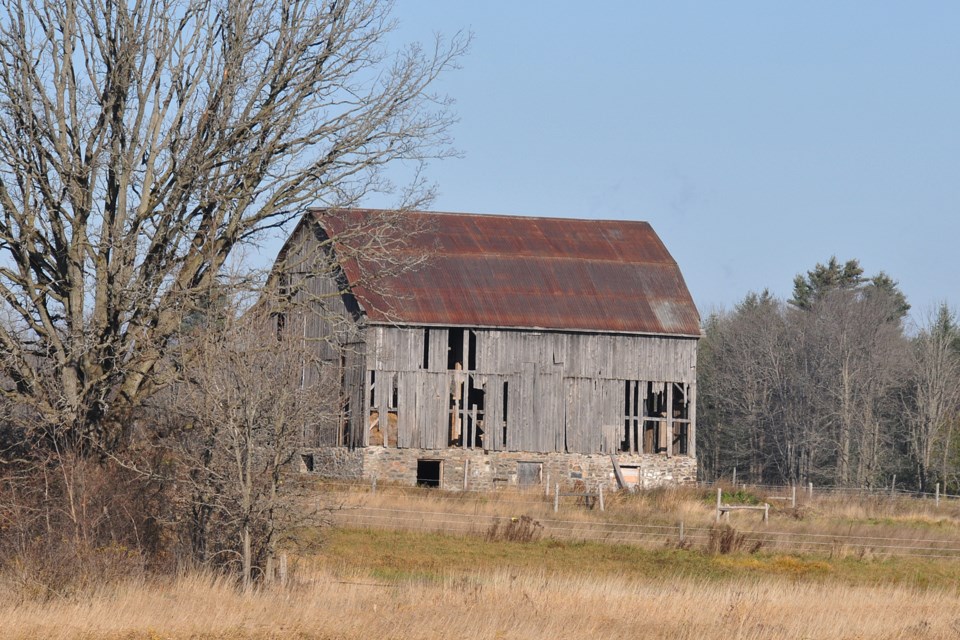They're disappearing quickly, although 'quickly' may be open to definition.
As one drives along the concession roads, side roads and back roads of our county, there are fewer barns to be seen with each road trip. Most are about 175 years old and, considering all that they've had to endure, it's remarkable how long and how well many of stood this test of time.
Wood frame barns have been an integral part of the rural landscape since European pioneers began the clearing of this once forested land. The original (and quickly assembled) small log structures, designed to shelter the oxen and a milk cow or two, were soon replaced with huge post-and-beam storage buildings, the outer walls sheathed in wide boards of locally cut pine or hemlock.
Good wood was used, good friends came to build them, and good use was made of these barns, most which were designed to house livestock, hay, grain and straw. A cream house was often found attached near the milking stalls. A solid stone foundation, made of either gathered field stones or chiseled limestone, ensured the structure stayed upright, plumb and level.
Their skeletons were made from locally cut and then hand-squared white pine beams, often running 80 feet or more in length, pinned together with dowels of ironwood. The building, or raising, of a barn was a huge community effort, the completed structure a monument of brute strength, skilled craftsmanship and hope.
But now they are disappearing, the weather finally taking its toll on the tough plant fiber we call wood. Decade following decade of high winds, heavy snow load, and soaking rains have weakened and brought down another three this spring.
Unfortunately, there is but only a glint of a chance that these marvellous barns will be restored; most have been abandoned and empty for several years.
But in their 'hay days' a barn was perhaps the most marvellous thing a farm child could imagine. It was full of not only cattle, hogs, and horses, but also a myriad of wild things — those birds, mammals and insects that adopted the barn as their home when their hollow home trees were removed.
The ridgepole was always a place to find cooing and strutting pigeons, the flock growing larger every year. Nesting high above between the rafters made them impervious to carnivore attacks (and small boys with sticks and BB guns).
Sharing the lofty reaches of the inner roof were the always common barn swallows, their tweaking calls a constant reminder of their presence. Mud nests were glued with clay to the pine poles, and small heads were occasionally seen when a parent bird flew in with a grasshopper lunch.
Within the loose straw there nested another winged creature, yet one to stay clear of — the bumblebee. They seemed to love the easy access through the loose straw stalks, to a place which remained sheltered from any rain. It took a brave lad with a long-handled pitchfork to throw down the night's bedding when a bee's nest was thought to be underfoot.
Raccoons were always present, their droppings appearing along beams and particularly in or near the granary. Mice and rats were also of the night, and while they didn’t do too much direct damage to the stored crops, their gnawing ruined many a leather harness. However, a pile of hemp fiber grain bags could be quickly reduced by these rodents to being a holey mess.
During the day the area around the barn was constantly busy, as starlings weaseled their way between loose boards to take food to their young, and English sparrows chipped happily as they rummaged for seeds within the manure pile. While not living within the barn, what barnyard was complete without a killdeer or two crying plaintively as you walked by?
Farming has changed drastically; what was done in the 1950s and '60s was basically the same as was done since the turn of the century. The biggest change was the replacing of good ol' Duke and Bess with a fuel-powered tractor. Then technology and economy combined, and farms had to become progressive. Steel barns, round bales stored outside, low diversity farming, and more mechanized methods of doing chores led to the great wooden barns being left to rot.
A few of these gentle giants have been salvaged, but as bits and pieces of weathered barn board or display accents of pine beam. Their time has come and gone.
As I drive the roadways and see the broken skeletons of these ancient and leaning barns, I pause to remember the 'good old days', and give thanks for the time I once spent playing in the grassy gangways of barns now gone. And wonder where all the wild animals live now.



